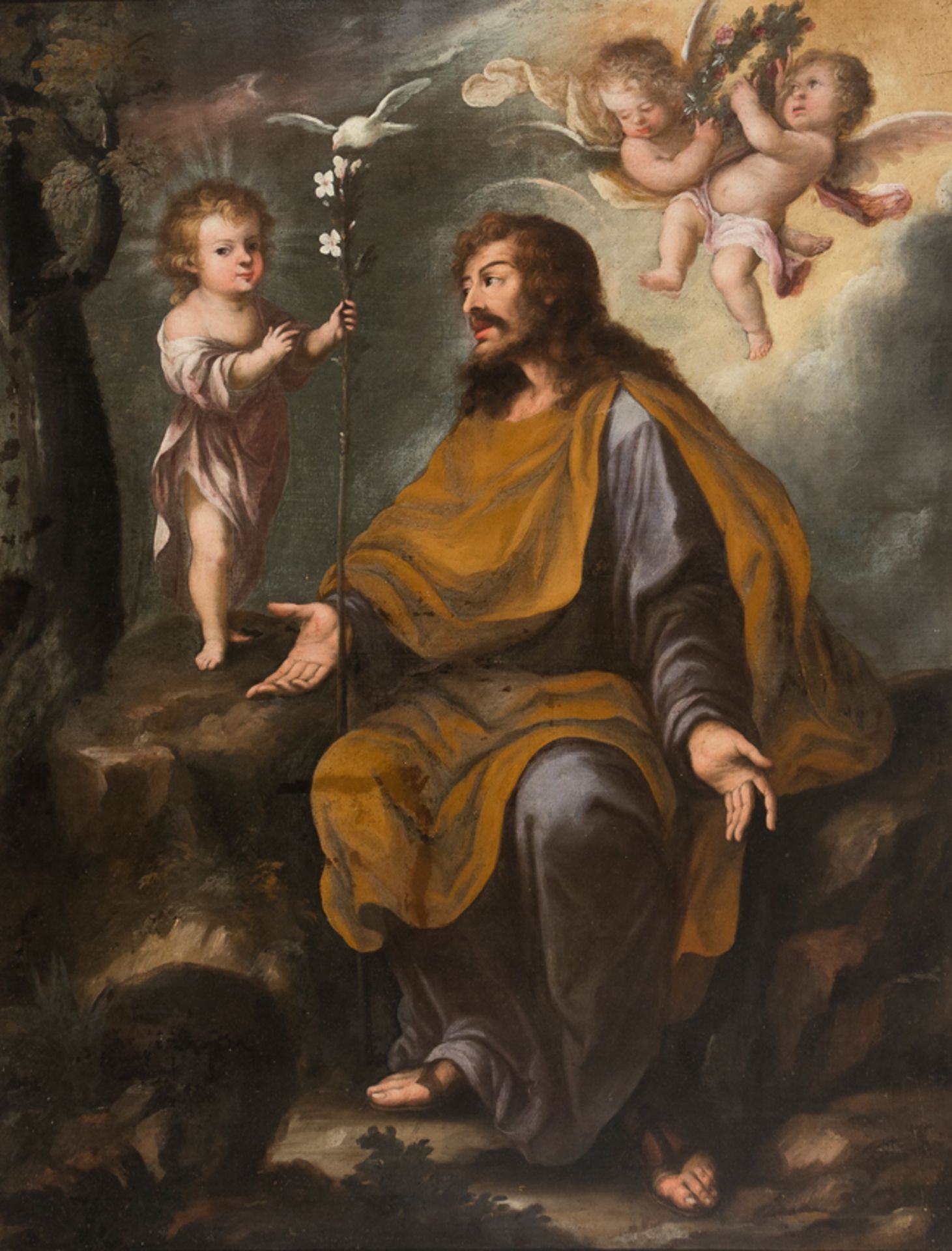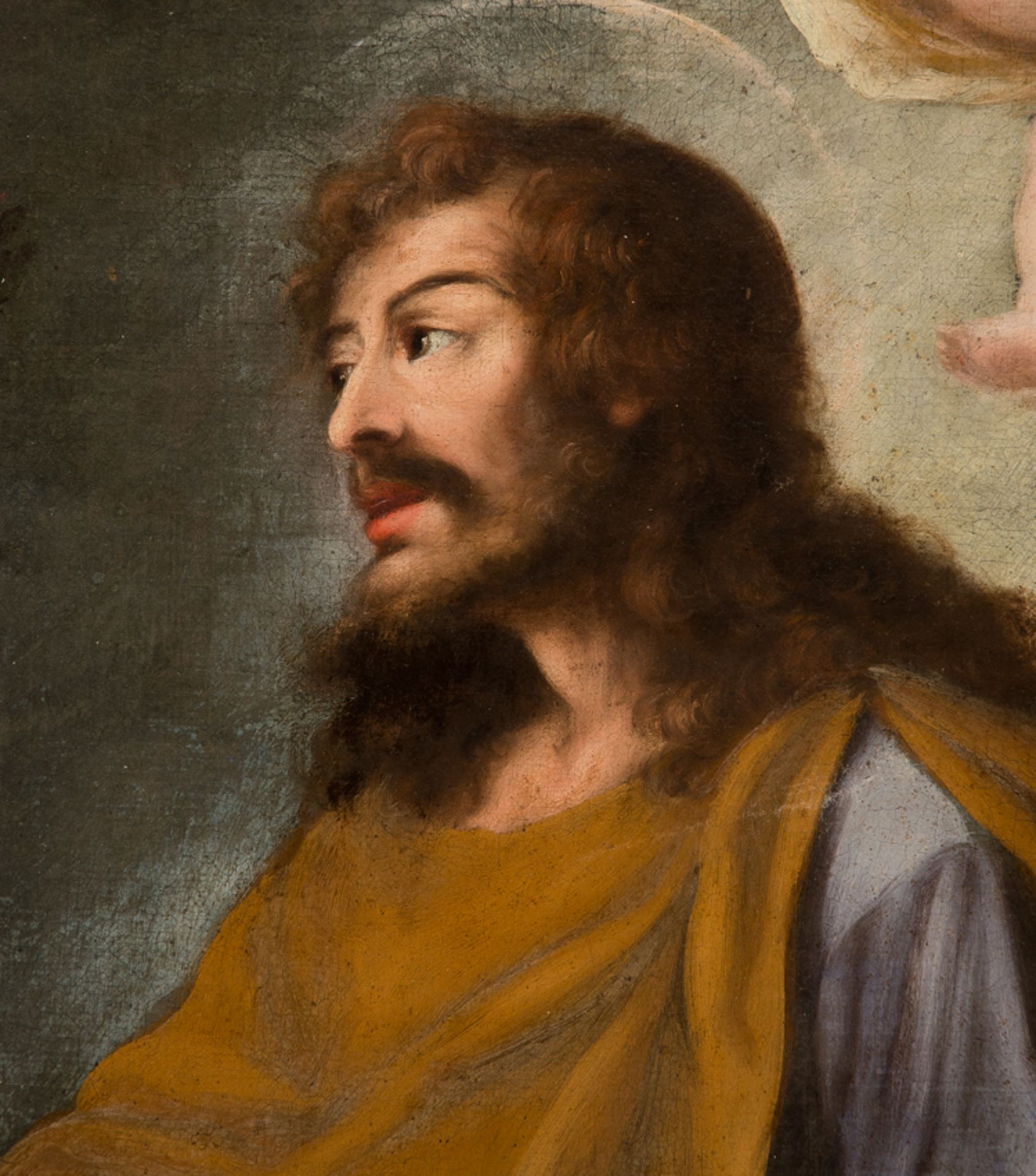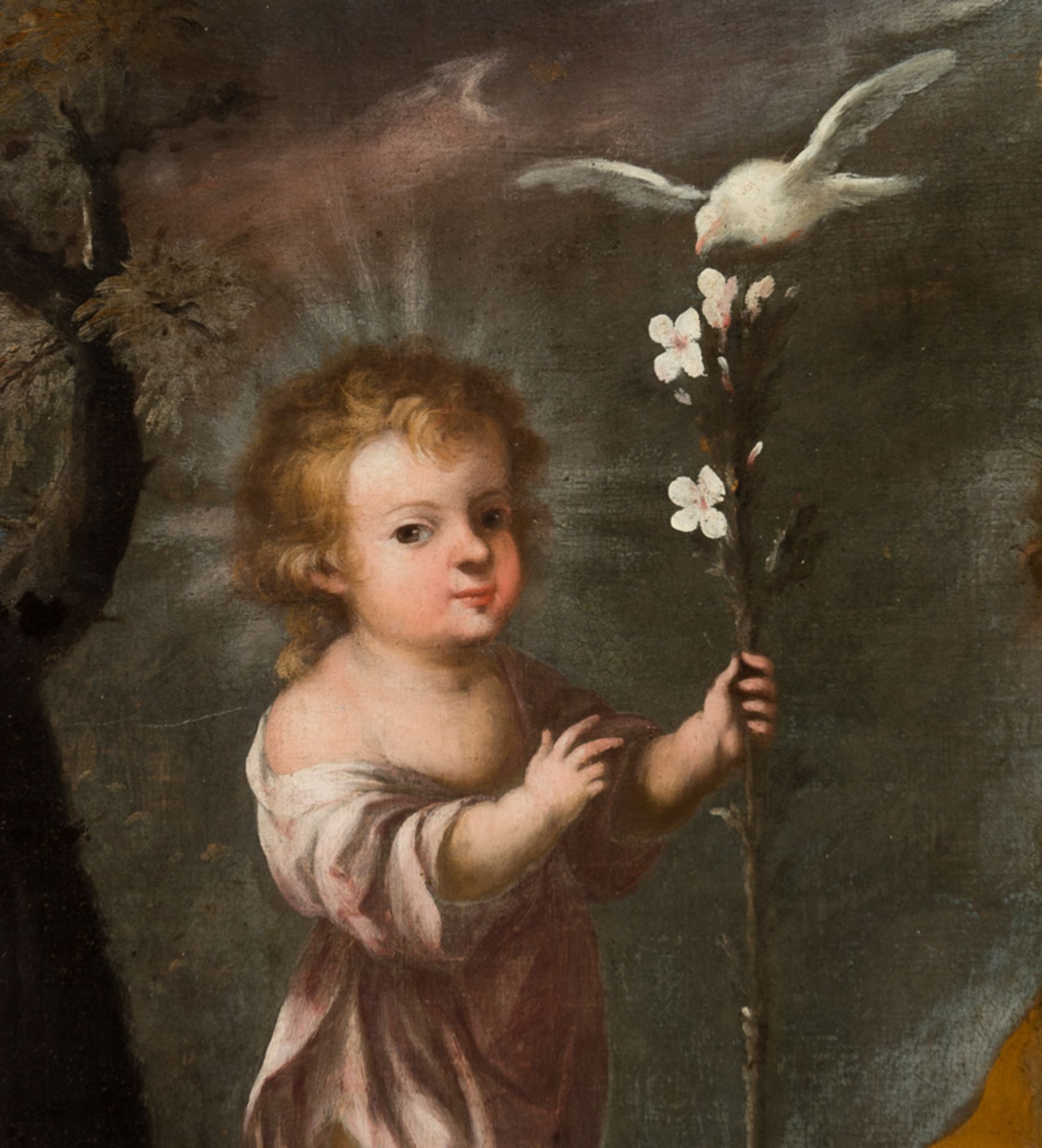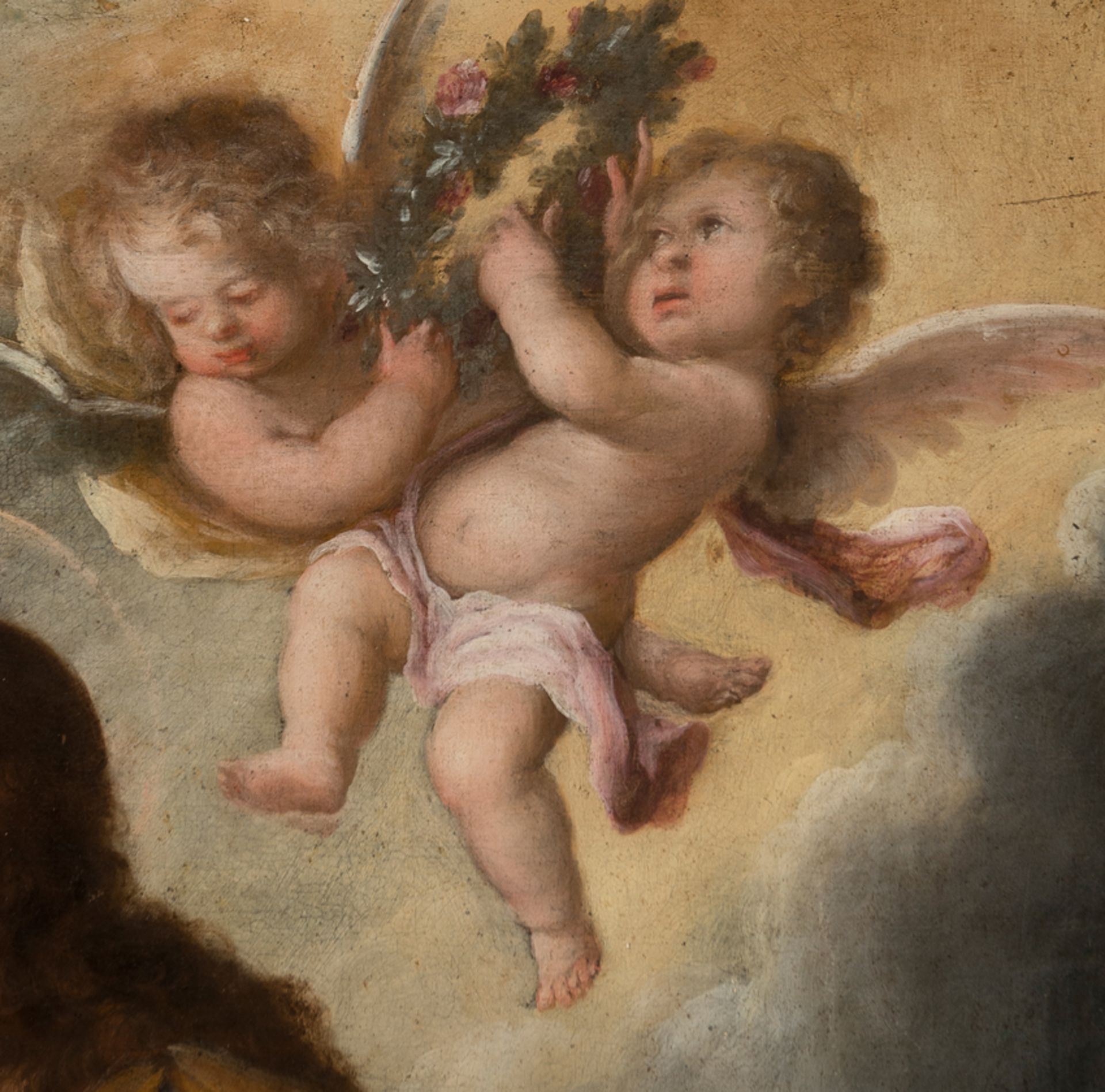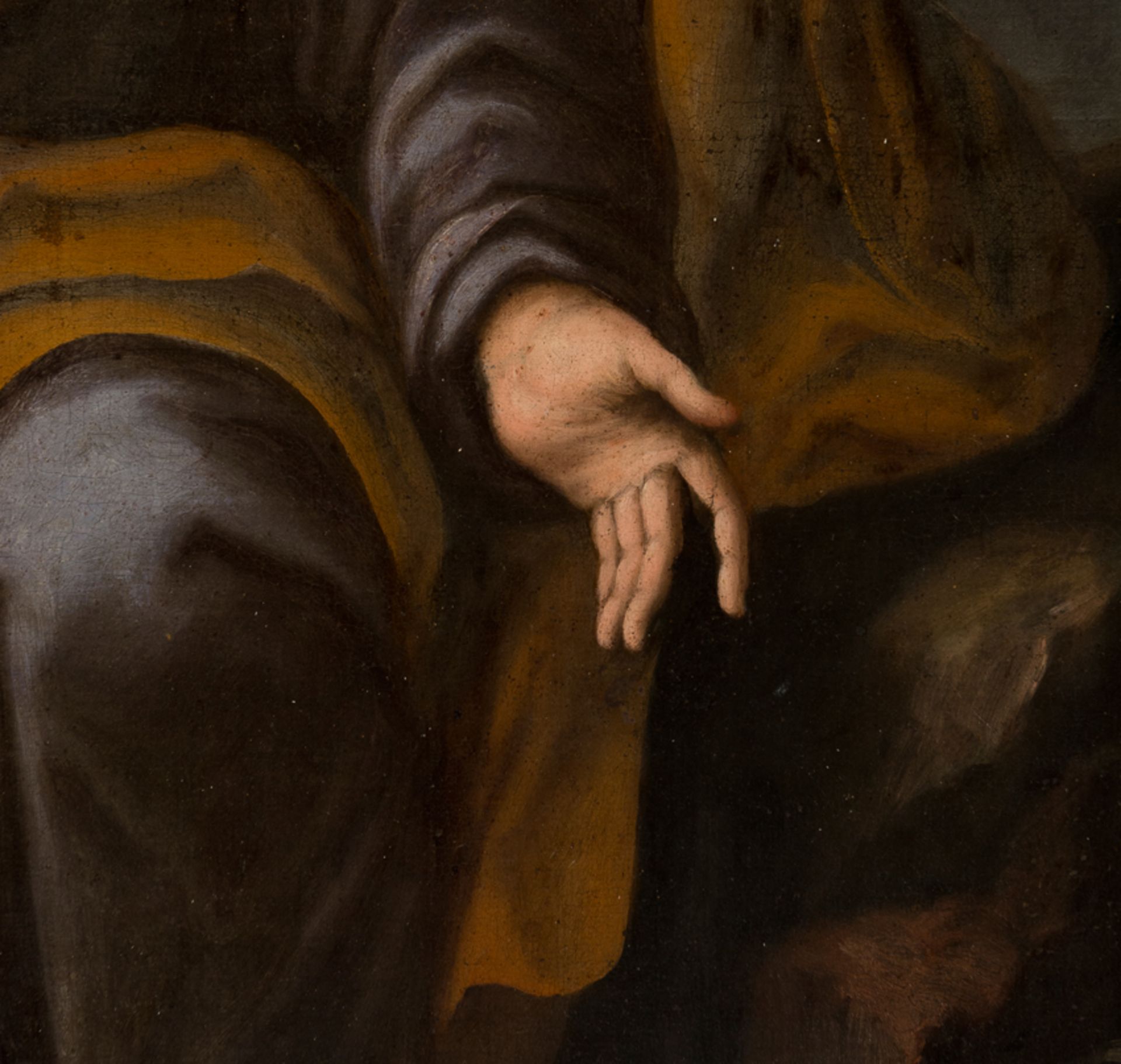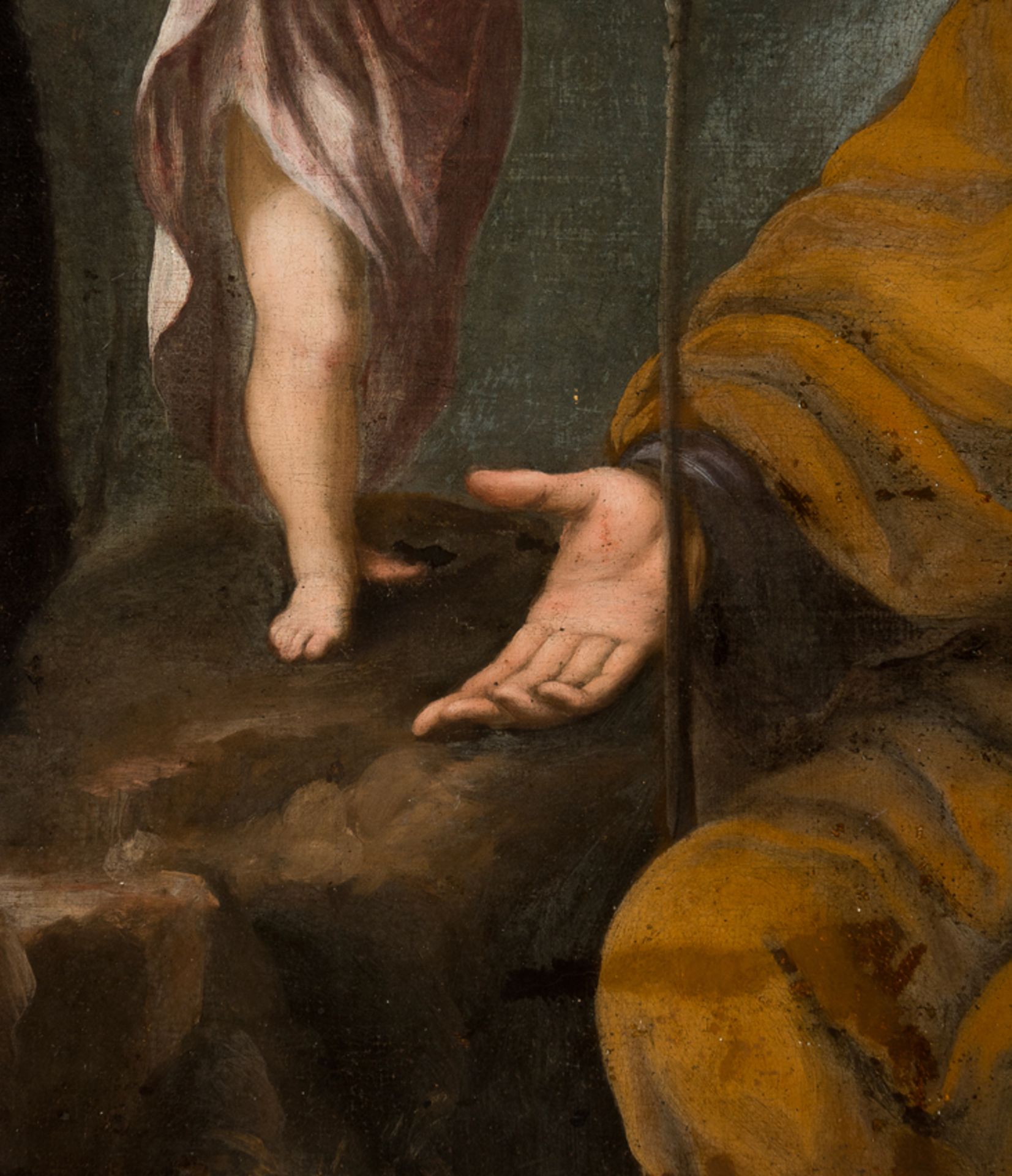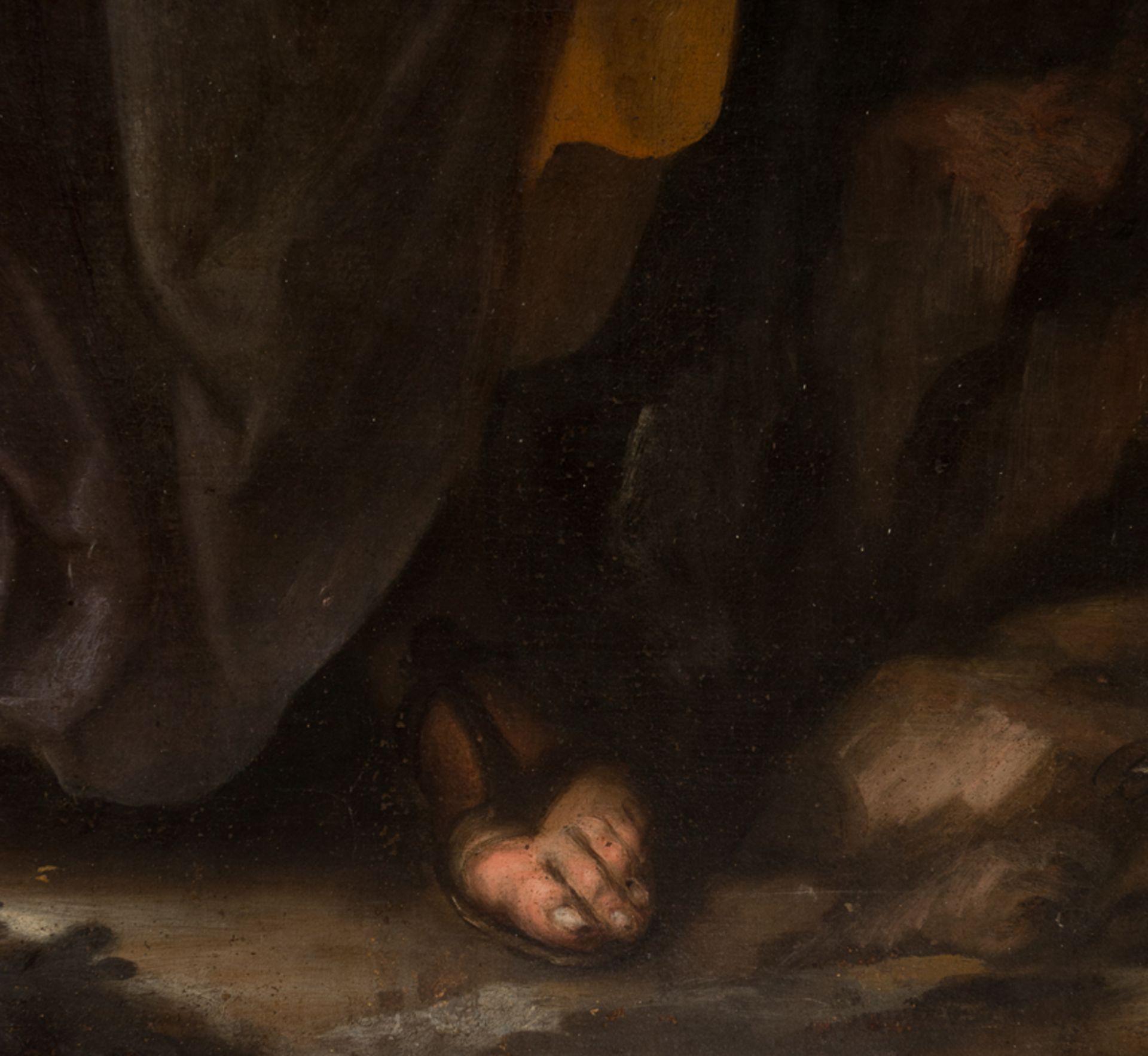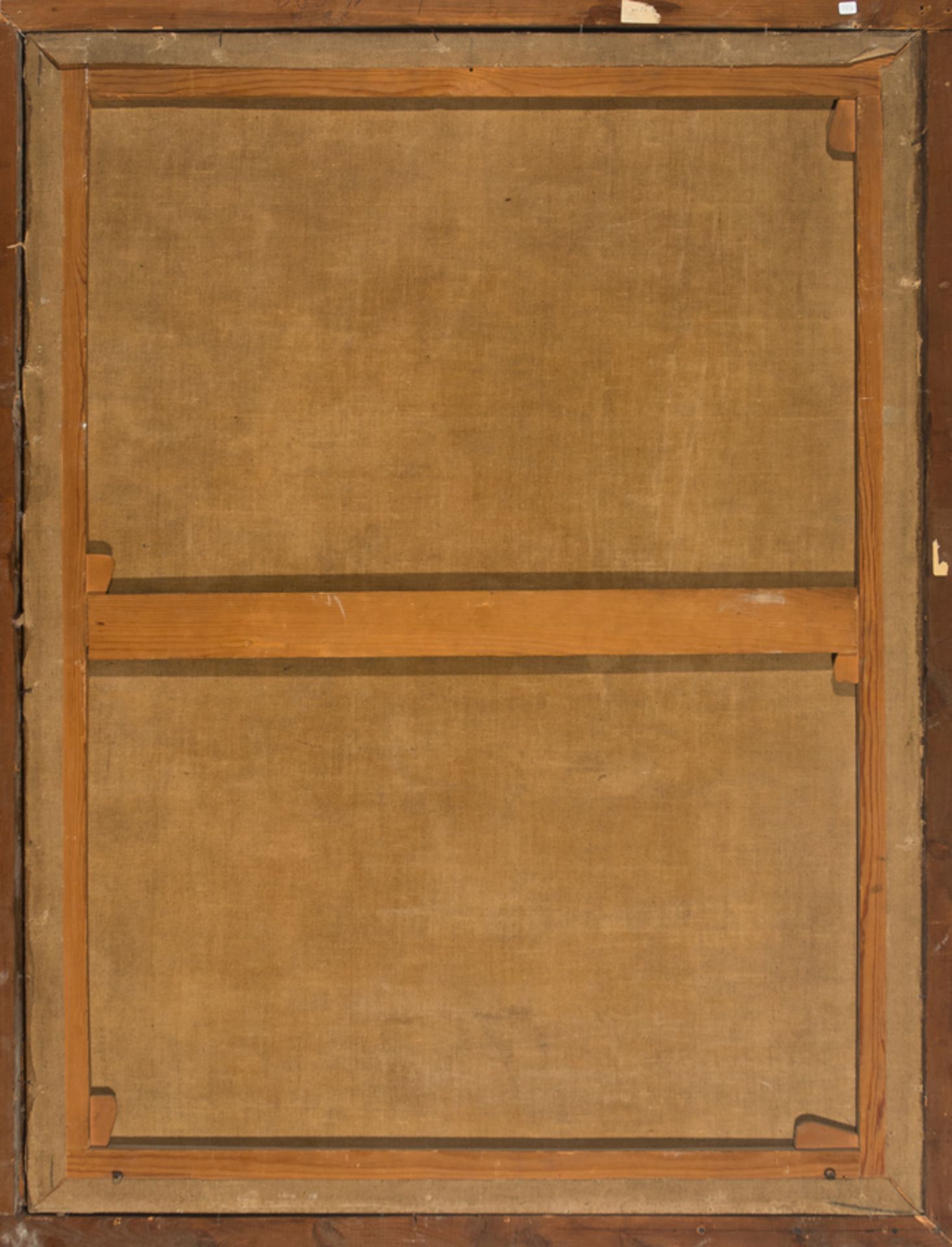52
Seville School. Late 17th century.
"Saint Joseph with the Child"
Oil on canvas. Relined. 125 x 96cm.
Worship of Saint Joseph increased notably in the city of Seville from the end of the 16th century and was consolidated throughout the 17th century, when the exceptional painter Bartolomé Esteban Murillo (1618-1682), often depicted the saint in different iconographies. He eliminated the emotional and sentimental distance that the paintings created in the decades prior to his artistic activity reflected. Murillo was able to create an intense relationship between the Father and the Son, linking them with deep feelings of tenderness and affection. His disciples and imitators managed to maintain this relationship between the two characters until well into the 18th century. This painting is a good example, and to this we must add a notable fact, which is that that it depicts a rather unusual iconography when it comes to Joseph - the Coronation or Glorification of Saint Joseph.
The anonymous painter, a follower of Murillo's aesthetics, has depicted the episode in a rocky landscape, ending on one side in an ancient trunk, on which the two main characters find a seat: Saint Joseph, seated on the right side, gazes lovingly at his Son at the same time as he opens his arms as if he had been surprised by the Child's sudden appearance. He wears a wide purple tunic and a yellow cloak fastened around the neck, classic colours of the saint's iconography. He has been portrayed as a young man with a sparse beard and abundant curly hair. The Christ Child is located on a separate and higher rock, and is standing and looking at us complicitly, so that he invites us into the scene, and blesses his Father at the same time that he goes to deliver the bouquet of lilies that commemorates his victory in the Marriage of the Virgin Mary and also one of his most usual attributes. The Child wears a flowing tunic that exposes a large part of his plump anatomy.
The scene is completed by the Dove of the Holy Spirit placed on the bouquet of lilies and a burst of Glory in the sky from which two little angels emerge who, in daring postures, prepare to place the crown that will glorify Saint Joseph for his role as Nursing Father of the Christ on the saint's head. The golden Glory from which the angels come stands out in striking contrast to the dark cloudy sky that accentuates the main figures in the painting and especially their heads surrounded by a nimbus (Saint Joseph) and radiance (Child Jesus).
The painting has been executed with fluid and precise brushstrokes that perfectly define the volumes of both the characters and the setting. The colour palette is generally earthy, which is why the powerful purples and yellows of the saint and the golds and pinks with which the Child Jesus and the Glory with the angels are painted stand out. The picture would have been painted at the end of the 17th century by an esteemed anonymous Sevillian master who cultivated Murillesque aesthetics, models and types.
We would like to thank Dr. Javier Baladrón, PhD in Art History, for identifying and cataloguing this work.
"Saint Joseph with the Child"
Oil on canvas. Relined. 125 x 96cm.
Worship of Saint Joseph increased notably in the city of Seville from the end of the 16th century and was consolidated throughout the 17th century, when the exceptional painter Bartolomé Esteban Murillo (1618-1682), often depicted the saint in different iconographies. He eliminated the emotional and sentimental distance that the paintings created in the decades prior to his artistic activity reflected. Murillo was able to create an intense relationship between the Father and the Son, linking them with deep feelings of tenderness and affection. His disciples and imitators managed to maintain this relationship between the two characters until well into the 18th century. This painting is a good example, and to this we must add a notable fact, which is that that it depicts a rather unusual iconography when it comes to Joseph - the Coronation or Glorification of Saint Joseph.
The anonymous painter, a follower of Murillo's aesthetics, has depicted the episode in a rocky landscape, ending on one side in an ancient trunk, on which the two main characters find a seat: Saint Joseph, seated on the right side, gazes lovingly at his Son at the same time as he opens his arms as if he had been surprised by the Child's sudden appearance. He wears a wide purple tunic and a yellow cloak fastened around the neck, classic colours of the saint's iconography. He has been portrayed as a young man with a sparse beard and abundant curly hair. The Christ Child is located on a separate and higher rock, and is standing and looking at us complicitly, so that he invites us into the scene, and blesses his Father at the same time that he goes to deliver the bouquet of lilies that commemorates his victory in the Marriage of the Virgin Mary and also one of his most usual attributes. The Child wears a flowing tunic that exposes a large part of his plump anatomy.
The scene is completed by the Dove of the Holy Spirit placed on the bouquet of lilies and a burst of Glory in the sky from which two little angels emerge who, in daring postures, prepare to place the crown that will glorify Saint Joseph for his role as Nursing Father of the Christ on the saint's head. The golden Glory from which the angels come stands out in striking contrast to the dark cloudy sky that accentuates the main figures in the painting and especially their heads surrounded by a nimbus (Saint Joseph) and radiance (Child Jesus).
The painting has been executed with fluid and precise brushstrokes that perfectly define the volumes of both the characters and the setting. The colour palette is generally earthy, which is why the powerful purples and yellows of the saint and the golds and pinks with which the Child Jesus and the Glory with the angels are painted stand out. The picture would have been painted at the end of the 17th century by an esteemed anonymous Sevillian master who cultivated Murillesque aesthetics, models and types.
We would like to thank Dr. Javier Baladrón, PhD in Art History, for identifying and cataloguing this work.
Legends, Myths and Symbols
Auktionsdatum
Ort der Versteigerung
Generelle Versandinformationen vom Auktionshaus verfügbar
The purchase price includes the delivery of the lots in the venue of the auction. Transporting to other destinations is at the own risk of the client. The customer must contact "LST", to give the corresponding instructions for such transporting. "LST" is not responsible for the packaging or any accident incurred during transportation.
Wichtige Informationen
Aufgeld / Premium: 22 %
Live: 3 %
USt auf beides / VAT on both: 21 %
AGB
CONDITIONS OF THE AUCTION:
I. REGISTRATION. To bid in the room customers must register at the beginning, filling out a form and picking a number that will identify them during the auction. Customers may be required to register in bank references or other guarantee system and if they do not prove the solvency "LST" will not accept bids and award the auction.
II. WRITTEN BIDS. "LST" will accept written bids, which will be formalized in the form provided by the room until the day before the auction. In such auctions, the room will bid in name of the client until the maximum stated in the offer and always at the lowest possible price. If there are two or more bids for the same amount, the one placed first will have the priority. Written bids received in advance, will have priority on the day of the auction.
III. TELEPHONE BIDS. "LST" will allow telephone bids, if interested people contact "LST" days before the auction providing personal data, ID card and the phone number which will be used by the staff of "LST" to call at the time of the auction. The buyer, within all the legal rights is making an offer for the asking price, when applies for telephone bid. "LST" will not take responsibility for any technical defects beyond its control, which may prevent to contact successfully the bidder during the auction.
IV. AUCTIONEER. The auction will be conducted by an auctioneer, director of the auction will be judge and arbitrator of it with full authority in its development, will award the lots to the highest bidder and is able to settle any controversy concerning lots sale, reject bids, divide lots or group them and remover objects from the room. Will be able to, if it is deemed suitable, not accept bids on the auction. His decision will be unappealable.
V. SALE OF LOTS. The lots are awarded to the highest bidder. Once the auctioneer blows the hammer, the buyer becomes responsible of the lot purchased, exempting "LST" of liability to for any damage and / or accidents that may occur. No refunds of lots.
VI. STARTING PRICE. The amount shown in the catalogue as the starting price for each lot will be, as a rule, the minimum selling price, except for exceptional cases where a reservation may be agreed upon with the seller or it set discretionary by the room.
VII. SCALE OF BIDS. The bids are set according to the following scale:
From 50.-€ to 200.-€…………………………………………..at 10.-€
From 200.-€ to 500.-€…………………………………… …25 in 25.-€
From 500.-€ to 1.000.-€………………………………..…..….50 in 50.-€
From 1.000.-€ to 2.000.-€………………………………..…100 in 100.-€
From 2.000.-€ to 5.000.-€……………………………….….250 in 250.-€
From 5.000.-€ to 10.000.-€…………………………………500 in 500.-€
From 10.000.-€ to 20.000.-€……………………………1.000 in 1.000.-€
From 20.000.-€ to 50.000.-€……………………………2.500 in 2.500.-€
From 50.000.-€ to 100.000.-€…………………………..5.000 in 5.000.-€
From 100.000.-€ to 100.000.-€………………………10.000 in 10.000.-€
From 200.000.-€ to 200.000.-€………………………25.000 in 25.000.-€
From 500.000.-€ to 500.000.-€………………………50.000 in 50.000.-€
VIII. RIGHT OF ADMISION. "LST" reserves the right to admission to the auction room and to reject, at its judgment, any purchase order, from clients whose solvency is not duly proved as well as not to sale auctions.
IX. SALE PRICES. The successful bidder of one or more lots must pay "LST" the final sale price achieves at auction, plus the 22 % plus 21% VAT on the commission, at total 26,62 % on Hammer Price.
X. CATALOG DATA. The catalogue data are obtained in order to careful research and advice, however, any responsibility is afforded about its accuracy. The lots will be auctioned in the state in which they are, not accepting any claims in restorations, breakage, damage, imperfections and, even description or numbering mistakes in the catalogue, in case of it, being the burden of the buyers to make sure before the auction that the description matches with their personal opinion about respective lot. The exhibition of the lots is intended to allow a perfect review and study of them.
XI. PAYMENT AND REMOVAL OF LOTS. Payment and removal of the lots will be held no later than five days following the auction. After this period expire without having the buyer removed the lot or lots purchases, it will accrue an expense of custody of 6 euros per day on each lot.
15 days after the auction without having the buyer paid and removes the sold lots, "LST" will inform the seller and there will begin judicial proceeding in order to obtain payment. The delay in payment by the purchaser of his/her sold lots will carry an interest increase at a rate of 1,5% per month.
XII. DELIVERY OF LOTS. The purchase price includes the delivery of the lots in the venue of the auction. Transporting to other destinations is at the own risk of the client. The customer must contact "LST", to give the corresponding instructions for such transporting. "LST" is not responsible for the packaging or any accident incurred during transportation.
XIII. RIGHT OF FIRT REFUSAL AND REPURCHASE. "LST" in order to article 38 of "Ley 16/1985 de 25 Junio del Patrimonio Histórico Español" (BOE. 155 June 29, 1985), will notify in advance to the Ministry of Culture, the content of their catalogues. Concerning the lots subject to the legislation referred to in the preceding paragraph, the Administration may exercise the rights of first refusal and repurchase according to the law. "LST" will watch over the protection of Artistic, Historical and Bibliographical Heritage of Spain. For customers out of European Community, a tax for export is required by the Administration.
XIV. VALUE ADDED TAX (I.V.A). This tax will be accrued on commissions of "LST" for buyers, using the rates prevailing on the date of the auction.
XV. DATA PROTECTION. In order to the "Ley 15/1999 de 13 de Diciembre, de Protección de Datos de Carácter Personal", the client authorize "LST", the inclusion of their data in a customer file, and for the promotion by "LST" of the objects at all times the rights of access, rectification or deletion of personal data by sending the appropriate request to the following address: LA SUITE SUBASTAS, C/ Conde Salvatierra, 8, 08006. Barcelona.
XVI. EXPRESS LEGAL JURISDICTION. These Conditions are governed by and interpreted in accordance with the rules of Spanish law. The mere act of participating in the auction as seller, buyer or bidder, implies acceptance of these Terms and Conditions.
Sales operations are understood to be held at the registered office of "LST", C/ Conde de Salvatierra, 8, 08006. Any dispute shall be taken to the competent courts of Barcelona, expressly waiving any other jurisdiction, in accordance with Article 55 of the "Ley de Enjuiciamiento Civil".


















